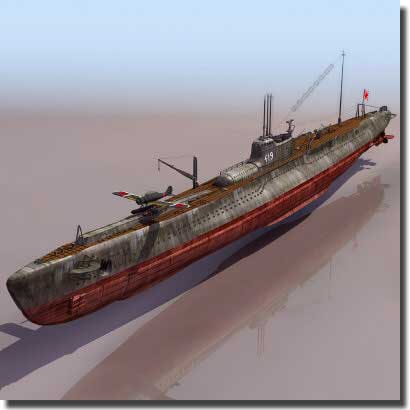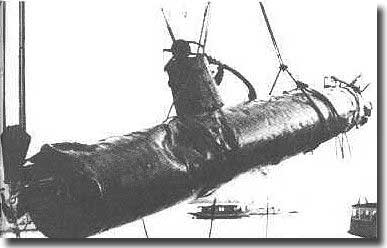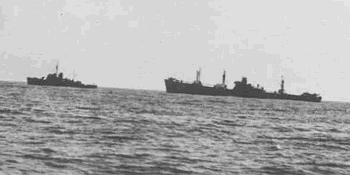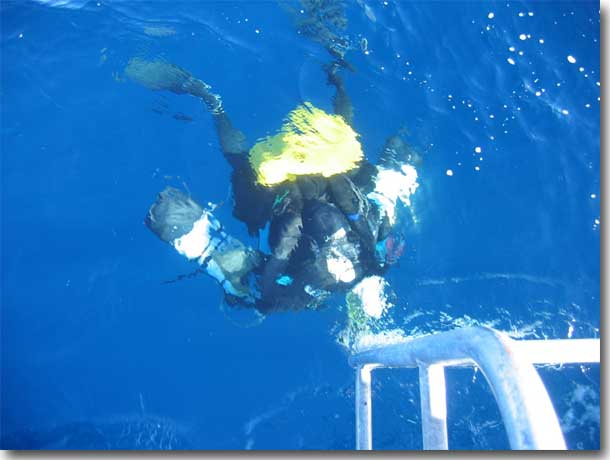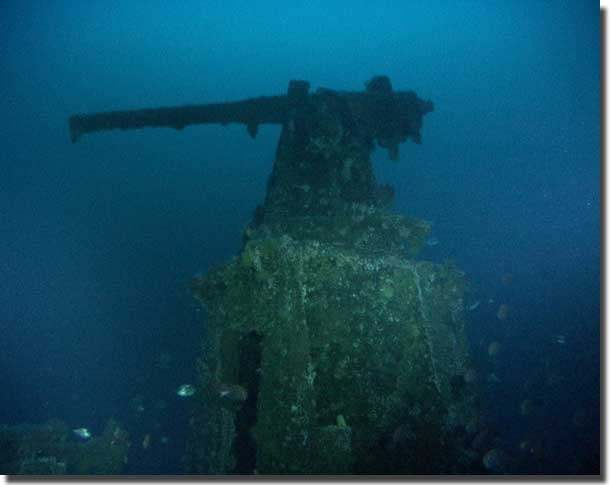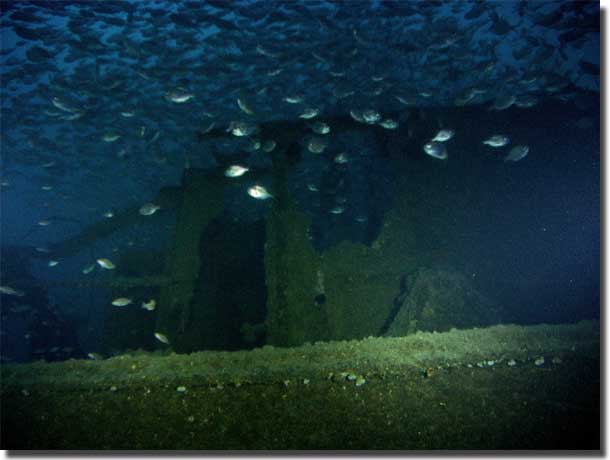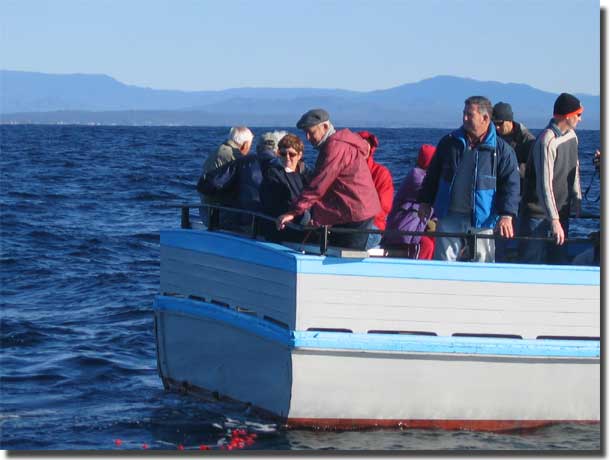|
Iron Knight sunk by Japanese Submarine I-21 in February 1943, wreck found June 2006
We gratefully aknowledge the quotes from John Stone, and other paraphrasing of Craig Allen's script, from the ABC Stateline, ABC News Canberra. Introduction.
They were off the fishing port of Bermagui when the Japanese Submarine I-21 sighted convoy funnel smoke 40 miles away. She tracked the convoy to fire a torpedo which passed under Townsville, but found its target on the leading ship of the starboard column Iron Knight at 0230 ( 2.30 AM ) on the 8th. of February 1943. She sank in less than 2 minutes taking 36 crew with her. History of Japanese Submarine I-21. After this sneak attack at Pearl, on the 23rd. of December, I-21 sank the 8,271 ton, Union Oil Company tanker Montebello, enroute from California to Vancouver, her crew abandoning her in four lifeboats. Early in 1942, this submarine returned to her homeland, then to operate in the Pacific Ocean, and sinking the 7,176 ton Liberty ship John Adams on the 5th. of May, she was carrying 2,000 tons of gasoline, and went up with a big bang! This was the first Liberty ship to be sunk in the Pacific. Two days later whilst on the surface, I-21 used gunfire to dispose of the Greek 4,641 ton vessel, Chloe.
I-21's Glen Floatplane flies reconnaissance flights. Japanese Midget Submarines attack Sydney Harbour, 31st. May/1st. June 1942. Two made it through the gate opening into the harbour, probably following a Manly Ferry, one became entangled in the anti-submarine boom mesh, a second, was sunk in Taylor Bay, and the third Midget A, under the command of Sub Lieutenant Ban fired a torpedo at USS Chicago, missed, to finish up exploding on the stone wall at Garden Island. This explosion destroyed the old wooden ferry, HMAS Kuttabul, killing 21 sailors, as it was used as an accommodation facility.
That night I was a Sub Lieutenant RAN in the heavy cruiser HMAS Canberra, secured to No. 1 Buoy in Farm Cove, close to the now Opera House site. Ban was unlucky not to sink USS Chicago, he most likely set his torpedo too deep, anticipating his target to be a battleship, as reported by Ito after his flight over the harbour. That momentous night, our defence some how muddled through, but we were indeed lucky to get away with it. Sub Lieutenant Ban managed to exit his Midget from Sydney Harbour, but did not make it back to his mother Submarine, and his Midget has still not been found to this day. As all the I Boats failed to recover their charges, they took off to continue their maurading against our merchant shipping.
Attack on Newcastle. I-21 sinks merchant ship on the 12th. of June. I-21 returns to Japan, and thence to patrol the Pacific. Serving in HMAS Canberra, I had been sunk at the Battle of Savo Island on the 9th. of August 1942, in the early stage of this operation. In October, I-21 fired 6 torpedoes at a Colorodo Class battleship, one explosion was heard, but 3 of her torpedoes stuck in their tubes, but were later safely extracted. The Liberty ship Edgar Allen Poe is hit by a torpedo fired from I-21, and her crew abandon her, she is then towed to Noumea but is deemed to be a write off. Over December 1942 this submarine is employed running in supplies to Japanese troops still holding out on Guadalcanal. Australian waters. Off Newcastle on the 23rd of January, the Liberty ship Peter H. Burnett crammed full with 18,154 bales of wool is attacked by I-21, she is towed to Sydney by the US mine sweeper Zane, and the Australian Corvette Mildura, and the cargo is saved, but the ship is a loss.
Reconnaissance flight over Sydney. Attack on Iron Knight. The submarine steamed into firing range and let go with a torpedo, which passed under Townsville, but went on to hit the BHP ore carrier, Iron Knight making for Whyalla. Laden with iron ore she sank like a stone in under two minutes, only 14 of a crew of 50 survived, taking to a raft to be rescued by the French Destroyer Le Triomphant. After the Canberra was sunk, I came home, had two weeks survivor's leave, to be sent off to join the old light cruiser HMAS Adelaide as one of her watch keeping officers, we were based at Fremantle undertaking convoy escort work in the Indian Ocean. At that stage, Le Triomphant was also based at Fremantle, our sailors nicknamed her the Reluctant Dragon, WHY? because when ordered to sea she so often pleaded boiler problems, not seemingly anxious to be at sea. She also carried live pigs on board as potential fresh meat, and to be windward of her was not pleasant because of the smell emanating from her live cargo. Smoke from convoy ships. During all of WW2, many a merchant ship came to a nasty end through emitting black funnel smoke, or ships in the same convoy did not adequately control the smoke belching from their funnels. A dead giveaway to any lurking submarine, be it German, Italian, or Japanese. Final victim off Australia of I-21. On the 16th. of March 1943, Commander Matsumura was relieved by Commander Ineda Hiroshi, but as a Captain in I-177, he is killed in action. Posthumously, he received a double promotion to Vice Admiral. Last victim of I-21. Death of I-21. Wreck of Iron Knight found in June 2006.
Thus in June 2006, a team including Samir Alhafith, ( who was born in Bagdad, but migrated to Sydney as a teenager where he learned his diving craft around Sydney Harbour, filming its wonderful underwater wild life.) descended 125 meters off Bermagui to discover Iron Knight, 63 years after her sinking.
In discussing this dive Samir told me: " Water visibility was 50 meters, we had zero current and took just 4 minutes to get down, and then spent 16 minutes on the actual wreck. This was followed by 4 hours of decompression time. It was a magical dive and by far one of the best wreck dives we did anywhere."
Crew of Iron Knight.
Family Members of the Iron Knight crew.
Conclusion. The Australian Federal Government has declared this vessel an Historic Shipwreck under their Historic Shipwrecks Act, thus protecting the remains of the 36 crew from becoming exploited from anyone who dives on the wreck. May they long rest in peace. Modern diving methods combined with the skill of the Sydney Project Dive Team have been successful in unlocking yet one more previously unsolved WW 2 shipwreck.
Details of the 20 B Class Japanese Submarines.
Here are the dive photos by Samir Alhafith and other members of the Dive Team, publised with his permission. The image ( 1 ) is Samir at the ladder. The net shows the Fishermen's net snagged on the bridge of Iron Knight. The gun is the ship's gun mounted to give her some protection. Starboard side of the ship's bridge. The relatives cast 36 poppies into the Pacific Ocean. one for each sailor who died. We gratefully aknowledge the quotes from John Stone, and other paraphrasing of Craig Allen's script, from the ABC Stateline, ABC News Canberra |


